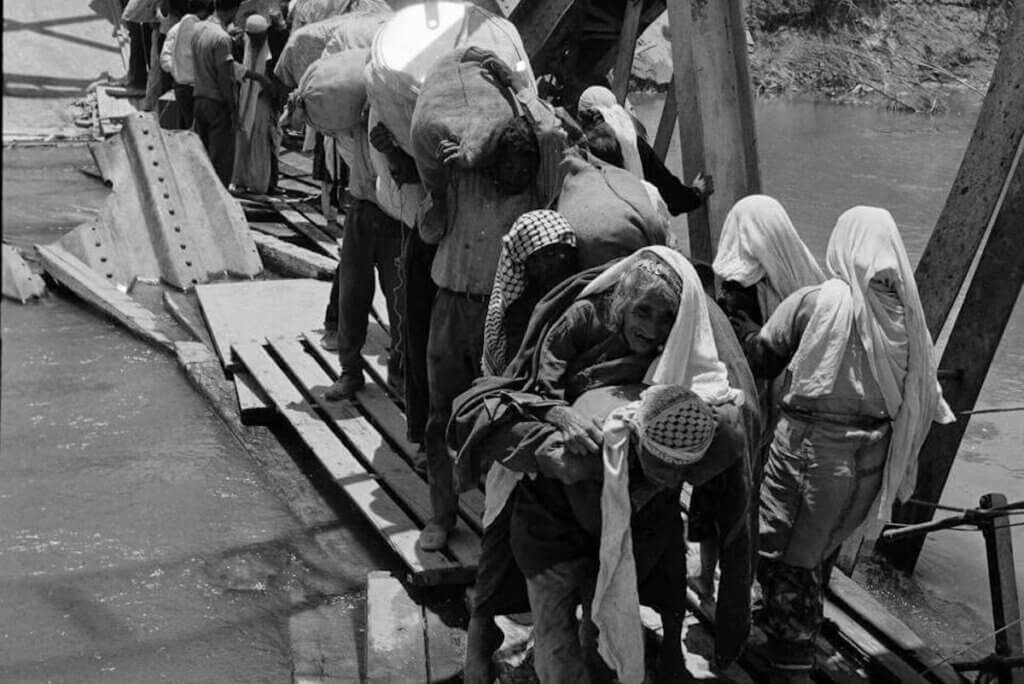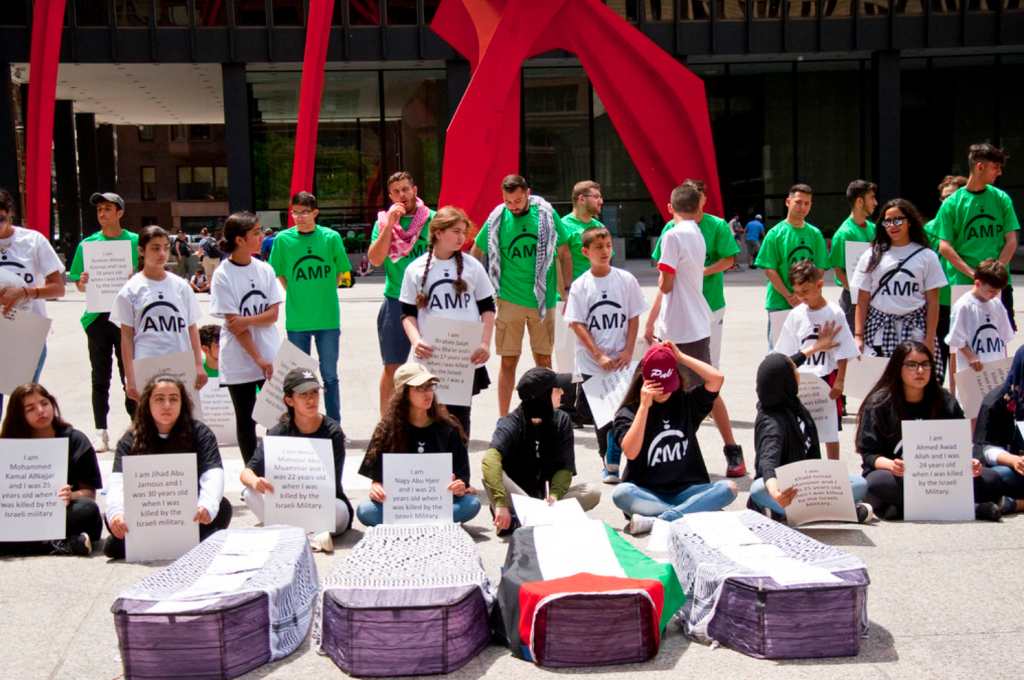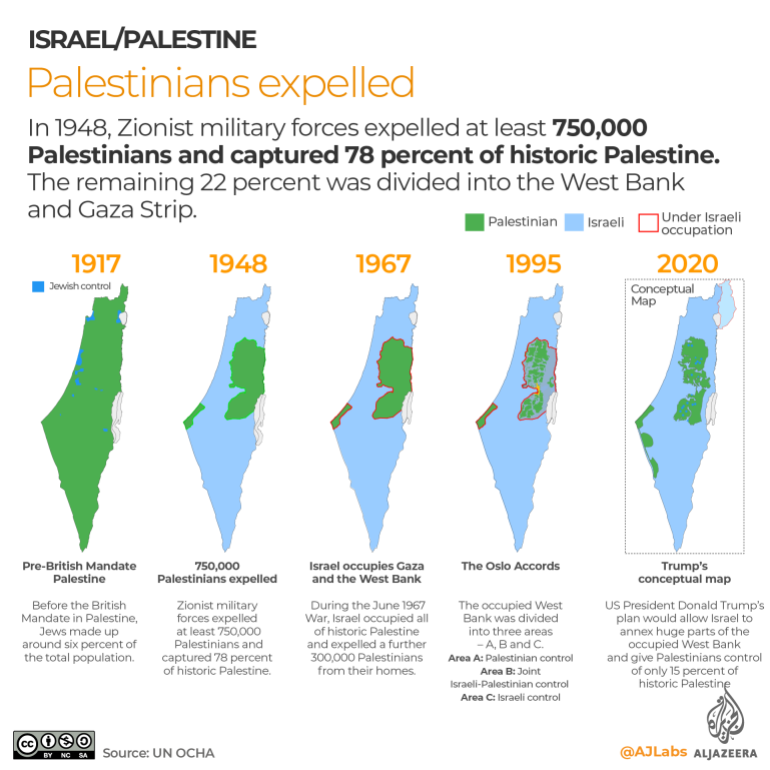56 Years of Israeli Occupation: Explaining the Palestinian ‘Naksa’
PALESTINE - ISRAEL, 12 Jun 2023
Yumna Patel | Mondoweiss - TRANSCEND Media Service
When Palestinians commemorate the Naksa, they are not only commemorating a historic loss of life and land, but the ongoing military occupation that every day, strips them of their rights to life, freedom, dignity and self-determination.

In this 1967 photo from the U.N. Relief and Works Agency, UNRWA, archive, Palestine refugees flee across over the Jordan river on the damaged Allenby Bridge during the 1967 Arab-Israeli war.
5 Jun 2023 – Today Palestinians are marking 56 years of Israeli military occupation. More commonly known as the Naksa, ‘setback’ or ‘defeat’ in Arabic, June 5th marks the first day of the six-day war, which culminated in Israel occupying the West Bank, Gaza, East Jerusalem, the Syrian Golan Heights, and the Egyptian Sinai Peninsula.
The Naksa took place in 1967, just nineteen years after the Nakba, or catastrophe, of 1948, when Israel was established on the lands of Palestine. During the Nakba, more than 750,000 Palestinians became refugees, and the new Jewish state had taken over an estimated 78% of the lands of historic Palestine. What was left of Palestine after the Nakba fell under Egyptian and Jordanian administration.
But following the six-day war, Israel took over control of the remaining 22% of Palestinian territory, enforcing a military occupation of the West Bank and Gaza, and the illegal annexation of East Jerusalem, in a move that was never recognized by the international community.
If the Nakba was the catastrophe that laid the foundation for Israel’s settler colonial state, the Naksa was the defeat that finished the job, setting off a chain of events that has come to define the reality on the ground in occupied Palestine over the past 56 years.
The lead up
To this day, the six-day war, or the ‘June war’, is celebrated by Israel and remembered by the West as a “David vs. Goliath” type of narrative. As the story goes, Israel, against all odds, defeated its aggressive Arab neighbors who were operating under the singular motive of trying to stamp out the young Jewish state.
Israel had no choice but to defend itself from certain annihilation, and in the process, it rightfully “captured” the rest of the Palestinian territory, as well as the Golan and the Sinai, as a matter of future protection against Egypt and Syria, who were determined to wipe Israel off the map. In other words, Israel had no choice, and by the grace of God, came out victorious.
Decades later, this narrative has continued to be perpetuated in the media, and even film and the arts. While the mainstream media, Israel, and the West still largely rely on this narrative, the lead up to the war paints a different picture.
The violence against Palestinians did not magically end after the Nakba. In the years after 1948, Israel killed thousands of Palestinians who attempted to return to their homes that they were kicked out from. Israeli forces also continued to commit massacres on Palestinian villages, as the rise of Palestinian Fedayeen, or freedom fighters, launched cross-border operations into Israel from Jordan, Egypt, and Syria with goals ranging from securing crops and belongings from stolen land to nationalistic resistance against Israeli military and settler targets.
In 1956 Israel, along with France and Britain, invaded Egypt with the goal of toppling Egyptian President Gamal Abdel Nasser, who had just nationalized the foreign-owned Suez Canal Company, which controlled the operation of the canal. This led to what is known as the Suez Crisis. Though international pressure forced the three powers to retreat, Israel celebrated a big win, securing access to operate through the Straits of Tiran, which Egypt had blocked to Israel since 1948. At the same time, tensions over the use of the water supply in the Jordan River were coming to a head, resulting in cross-border confrontations between Syria and Israel in the early 1960s.
In May 1967, under false Soviet intelligence stating that Israel was planning to invade Syria, with whom Egypt had a mutual defense treaty, Egypt ordered the evacuation of UN troops (who had been stationed there since the Suez Crisis) from the Sinai, and replaced them with Egyptian troops. Abdelnasser subsequently closed the Straits of Tiran in the Red Sea to Israeli shipping, which Israel called an “act of war.” By the end of May, Egypt had also signed mutual defense pacts with Jordan and Iraq.
On the morning of June 5, Israel launched a surprise attack on Egypt, bombing its air forces while they were still on the ground, dealing a heavy blow to the Egyptian military. The “preemptive strike”, followed by an Israeli ground invasion into the Sinai and Egyptian-administered Gaza Strip, was the catalyst for the war that would go on to last for six days, and claim an estimated 20,000 Arab lives, and less than 1,000 Israeli lives.
The aftermath of the war
Though the Arab armies suffered great losses, politically, militarily, and in terms of casualties, it was the Palestinians, in the end, who had the most to lose — and they did. Israel took control of what was left of Palestine under the guise of “freeing them from ‘illegal’ occupation” by the Arabs.
In addition to enforcing a military occupation in the West Bank and Gaza, Israel also occupied the Egyptian Sinai and the Syrian Golan Heights. Though the Sinai was returned to Egyptian control in 1982, the Syrian Golan remains in Israeli control until today.
Israel had also taken control of the Old City of Jerusalem from Jordanian forces, subsequently annexing the Eastern part of the city into Israel’s municipal boundaries, a move that was never recognized by the international community and is still considered to be an illegal annexation of the territory. An entire quarter of the Old City, the Moroccan quarter, was destroyed by Israeli forces, displacing an estimated 100 Palestinian families in order to make Jewish access to the Western Wall easier.
According to rights groups, around 7,000 hectares of land were illegally annexed into Israel’s municipal boundaries of Jerusalem. The goal was simple: try to take as much land as possible with the least amount of Palestinians to maintain a Jewish demographic majority in the city. Densely populated Palestinian areas were drawn out, while sparsely populated but land-dense areas were drawn in.
In the process of Israel’s annexation of Jerusalem, and occupation of the rest of the Palestinian territory, Israeli forces wiped out several Palestinian villages and expelled thousands from their lands. It is estimated that between 280,000 to 325,000 Palestinians were displaced from their homes and became refugees, in addition to another 100,000 Syrians.
In the months following the war, Israel conducted a census that deliberately excluded the displaced Palestinians in the war to prevent them from returning to their homes. According to the census, around 1 million Palestinians were living in the West Bank and Gaza at the time.
In order to avoid a demographic disaster, Israel did not annex the West Bank and Gaza as it did with Jeruaslem. Instead, it enforced a military occupation and a series of laws and measures aimed at grabbing as much land as possible and putting it under the control of the military and the state.
Israel achieved this through two primary policies: closed military zones and Jewish settlements.
Beginning in August 1967, less than two months after Israel occupied the West Bank, it began designating swaths of land in the Jordan Valley of the West Bank as closed military zones, making the land inaccessible and unusable to its Palestinian landowners. According to B’Tselem, by the end of 1967, Israel had declared almost 68,500 hectares of land as closed military zones. Between 1967 and 1975, Israel declared more than 26% of West Bank land closed military zones, making them off-limits to Palestinians unless they obtain a special permit, issued by Israel.
At the same time, Israel began promoting the settlement of Jewish citizens in the occupied territory – a flagrant violation of international law. The first West Bank settlement, Kfar Etzion, was established in September, just three months after the occupation began. In the first 10 years of the occupation, thirty settlements had been built in the West Bank alone, amassing a population of more than 4,500 settlers.
Settlements were built in strategic areas like the Jordan Valley (which holds most of Palestine’s water reserves), land around Jerusalem, and across the areas of the West Bank with a low population density of Palestinians.
In East Jerusalem, a third of the annexed land was expropriated for settlement use, despite being largely privately owned by Palestinians. Eight settlements were built in east Jerusalem in the first 10 years. In Gaza, four settlement blocs were built in the span of just three years (1970-1973) with the strategy of breaking up the contiguity of Palestinian areas.

A Die-In protest against Israeli Defense Forces killing unarmed Gazan civilians in Chicago, Illinois.
(Photo from Openverse by Charles Edward Miller on May 31, 2018)
The occupation today
56 years on, Israel’s military occupation has not ended. Rather, it has taken on new life.
Over the course of the past five and a half decades, Israel has continued to enact a number of laws and policies that serve the chief goal of further expanding Israel’s control in the territory, through land grabs, settlement construction, and the violent subjugation of the Palestinian population.
When closed military zones and settlements were not enough, Israel began confiscating land from Palestinian owners under the guise of environmentalism, declaring more than 6% of the land in the West Bank as Nature Reserves. By rewriting laws and using self-serving, distorted interpretations of old Ottoman-era land codes, Israel has, and continues to, declare massive swaths of West Bank land as State Land, thereby confiscating it from its Palestinian landowners and turning it over to the settlements.
Through the construction of the Separation Wall, the majority of which has been built on Palestinian territory well beyond the Green Line, Israel has seized even more land, effectively annexing West Bank land into Israeli territory. The wall is still under construction today.
Today, there are at more than 270 illegal settlements and outposts across the West Bank and East Jerusalem, with a settler population of around 630,000. While Palestinians are being kicked out of their lands in places like Masafer Yatta, under the pretext of living in closed military zones, Israel continues to promote settlement expansion and protect increasingly violent settler communities.
In Gaza, Israel has enforced a 16-year air, land, and sea blockade, taking military occupation to new heights. Where checkpoints, settlements, and Israeli army foot raids are a daily occurrence in the West Bank, air strikes, devastating military offensives, and constant war are the reality in Gaza.
Across the occupied Palestinian territory, Israel controls every aspect of life, from the population registry, to borders and checkpoints. Even in parts of the West Bank that are under the full control of the Palestinian Authority (only around 18% of the West Bank), Israel’s military still controls the borders and conducts routine deadly raids in the heart of Palestinian cities.
Palestinians continue to be imprisoned and killed at alarming rates, with rights groups coming out in increasing numbers to say that in addition to military occupation, Israel is committing the crime of apartheid, not only in the occupied West Bank and Gaza, but in East Jerusalem and against Palestinian communities in Israel as well.
When Palestinians commemorate the Naksa, they are not only commemorating a historic loss of life and land but the ongoing military occupation that, every day, strips them of their rights to life, freedom, dignity, and self-determination.
Go to Original – mondoweiss.net
Tags: BDS Boycott Divestment Sanctions, Colonialism, Cultural violence, Direct violence, Ecocide, Gaza, Genocide, Israeli Apartheid, Israeli Army, Israeli occupation, Middle East, Nakba, Palestine, Palestine/Israel, Sociocide, State Terrorism, Structural violence, Violent conflict, West Bank, Zionism
Join the BDS-BOYCOTT, DIVESTMENT, SANCTIONS campaign to protest the Israeli barbaric siege of Gaza, illegal occupation of the Palestine nation’s territory, the apartheid wall, its inhuman and degrading treatment of the Palestinian people, and the more than 7,000 Palestinian men, women, elderly and children arbitrarily locked up in Israeli prisons.
DON’T BUY PRODUCTS WHOSE BARCODE STARTS WITH 729, which indicates that it is produced in Israel. DO YOUR PART! MAKE A DIFFERENCE!
7 2 9: BOYCOTT FOR JUSTICE!
DISCLAIMER: The statements, views and opinions expressed in pieces republished here are solely those of the authors and do not necessarily represent those of TMS. In accordance with title 17 U.S.C. section 107, this material is distributed without profit to those who have expressed a prior interest in receiving the included information for research and educational purposes. TMS has no affiliation whatsoever with the originator of this article nor is TMS endorsed or sponsored by the originator. “GO TO ORIGINAL” links are provided as a convenience to our readers and allow for verification of authenticity. However, as originating pages are often updated by their originating host sites, the versions posted may not match the versions our readers view when clicking the “GO TO ORIGINAL” links. This site contains copyrighted material the use of which has not always been specifically authorized by the copyright owner. We are making such material available in our efforts to advance understanding of environmental, political, human rights, economic, democracy, scientific, and social justice issues, etc. We believe this constitutes a ‘fair use’ of any such copyrighted material as provided for in section 107 of the US Copyright Law. In accordance with Title 17 U.S.C. Section 107, the material on this site is distributed without profit to those who have expressed a prior interest in receiving the included information for research and educational purposes. For more information go to: http://www.law.cornell.edu/uscode/17/107.shtml. If you wish to use copyrighted material from this site for purposes of your own that go beyond ‘fair use’, you must obtain permission from the copyright owner.
Read more
Click here to go to the current weekly digest or pick another article:
PALESTINE - ISRAEL:
